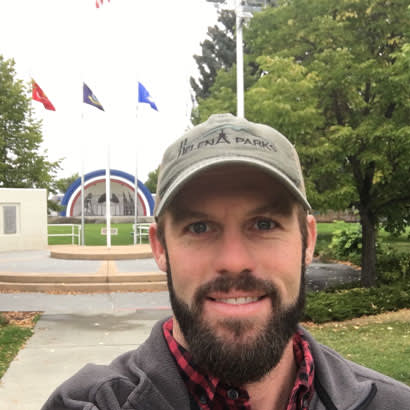
Growing up in Helena, Montana, Patrick Marron spent much of his spare time at the park across the street from his house — playing on the playground equipment and engaging in sports with his friends. As a high school student, Marron spent summer vacations as a seasonal employee for Helena Parks and Recreation, assisting the park maintenance staff by mowing lawns and trimming trees and plants. It’s a job he thoroughly enjoyed.
In college, Marron earned an associate’s degree in fire science with the goal of becoming a firefighter. However, his love for the great outdoors would steer him back to parks and recreation. In 2009, he rejoined Helena Parks and Recreation as a full-time maintenance worker and gradually worked his way up to maintenance supervisor in 2016.
Parks & Recreation magazine recently sat down with Marron to discuss his role at Helena Parks and Recreation, how social equity plays a part in his work and why he doesn’t see himself changing careers anytime soon.
Parks & Recreation: Tell us about your position with Helena Parks and Recreation.
Marron: As the maintenance supervisor, I’m in charge of day-to-day operations for park landscapes, hardscapes, playgrounds athletic fields and sports courts. We have a pool and a couple of buildings that we also maintain. It’s my job to make sure the crew is working safely and getting things taken care of for the public. Depending on the size of the park project, we do a lot of in-house design for irrigation, playgrounds and landscaping. Of course, if it’s a bigger project that requires a lot of engineering, we’ll subcontract that out, but we do quite a bit of landscape design. In the past 10 years, we’ve put in a lot of playgrounds. Right now, we’re doing a big park remodel and working with user groups and outside entities on designing it.
P&R: How does social equity fit into what you do?
Marron: Anytime we put in playgrounds, buildings — anything that the public is going to have a lot of interaction with — we definitely want to make sure all groups can access them. We take into account the history of a neighborhood and what the people of that neighborhood want to see and then we tailor those amenities to each area, depending on the park and the neighborhood it’s in. For the past three years, we’ve been working on a vacant lot located in an underserved community, and we have turned it into an edible garden. We’ve had a lot of community involvement with the park’s design and maintenance, because we want those folks to be more involved and take ownership of the park.
We had another unique situation here in Helena with regard to social equity. Helena had a fountain in one of our parks that was dedicated to the city by ‘The United Daughters of the Confederacy.’ It was the Northern-most Confederate monument. The city commission decided to remove the fountain last summer because of other incidents around the country. It created some controversy, but the city was successful in removing it. Multiple groups are now working together to design a new ‘Equity Fountain’ to replace the Confederate fountain. Other Confederate monuments/statues have been removed, but this will be the first Confederate monument to be replaced with something new promoting unity.
P&R: What challenges do you face with regard to accessibility?
Marron: Everybody definitely wants more access. One challenge that we face here in Helena is we’re running out of available green space within the city limits. Our biggest need is probably more athletic fields for programs and other adult athletics. Unfortunately, we don’t have a lot of room for big, open fields. We also have a great trail system that people just love, but they want more access to those trails, which can create its own set of problems.
P&R: What makes your job the most rewarding?
Marron: Of course, I love to drive by our parks and see the people out there playing and enjoying them, but I really enjoy the people I work with. Our crew is a hardworking staff, and it’s great to get everyone’s opinions and work together toward solving problems. My supervisors are also very supportive and encouraging. They’re not afraid of change, and they’re always willing to try new things — that’s something I really appreciate.
P&R: What advice would you give to others who are thinking about parks and rec as a career?
Marron: Just go for it. There are positions within parks and rec that are rewarding, fun jobs. The industry is always changing, so it’s never boring. People get off work and then they go to the park, but we get to spend all day there and get paid for it. I love seeing the kids and seniors using the park, and it’s really rewarding to see the people out there enjoying your work.
P&R: In your opinion, how do parks benefit a community?
Marron: There are a lot of benefits from parks. I believe the biggest benefit I see in our area is getting people outside. Montanans love to recreate, especially when it comes to our mountains, rivers and lakes. Here, there are tons of recreational opportunities, which can, sometimes, make it a challenge for a park department to compete. But, we provide safe, accessible areas for people year-round. We have a lot of cold, snowy, long winters and it’s important for us to provide areas for people to get out and use during that time of the year. And then in the summer, instead of driving to the mountains or the lakes, we provide recreational opportunities closer to home for people who don’t have the time or money to travel. What’s more, we have a great trail system right in our backyard, along with swimming opportunities and other programs right here in town.
— Vitisia Paynich, Freelance Writer for Parks & Recreation magazine

